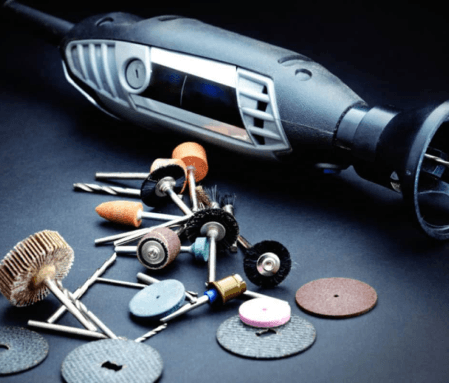
In the realm of precision work, wherein every fraction of a millimeter counts, the skill of grinding tools could make all the difference. Whether you are crafting difficult equipment elements, honing sensitive contraptions, or sculpting creative creations, know-how and adeptly employing distinct styles of grinding tools are paramount. From handheld grinders to sophisticated CNC machines, each device offers precise talents and nuances. In this comprehensive guide, we will delve into the sector of precision grinding, exploring diverse equipment and strategies to attain impeccable results.
1. Angle Grinders: Versatile Powerhouses
Angle grinders are ubiquitous in workshops and construction sites for their versatility and strength. Equipped with abrasive discs, those hand-held tools excel in obligations ranging from tough shaping to quality detailing. When operating with steel, stone, or ceramics, perspective grinders can hastily take away fabric with precision. However, their high-pace rotation needs caution and a regular hand to avoid over-grinding or damaging the workpiece. Utilize special grit discs to reap various tiers of smoothness and precision, and constantly prioritize safety via sporting appropriate shielding gear.
2. Bench Grinders: Stability and Control
For obligations requiring stability and control, bench grinders are fundamental. Mounted securely to a workbench or pedestal, those stationary tools have rotating wheels appropriate for sprucing blades, shaping metal, and refining edges. Bench grinders include exclusive wheel grits, taking into consideration coarse grinding for cloth removal and pleasant grinding for precision completing. To ensure accuracy, preserve regular pressure and use light, controlled actions. Additionally, frequently investigate and get dressed the grinding wheels to keep their effectiveness and save you from overheating.
3. Surface grinders: precision redefined
When absolute precision is non-negotiable, surface grinders come into play. These machines make use of a horizontally rotating grinding wheel to supply flat, clean surfaces with wonderful accuracy. Commonly hired in tool and die making, mildew production, and precision engineering, surface grinders excel at attaining tight tolerances and impeccable surface finishes. Operators need to meticulously install the workpiece and alter grinding parameters to achieve the desired results. Moreover, getting to know the intricacies of floor grinding requires staying power, talent, and interest in detail.
4. Cylindrical Grinders: Perfecting Roundness
For cylindrical additives requiring specific dimensions and surfaces, cylindrical grinders are fundamental. These machines have a rotating wheel and a workpiece holder capable of producing cylindrical shapes with extremely good accuracy. Widely used within the automotive, aerospace, and production industries, cylindrical grinders can achieve micron-stage tolerances and replicate-like floor finishes. Operators ought to meticulously align the workpiece and grinding wheel to ensure concentricity and uniformity. Additionally, gaining knowledge of cylindrical grinding entails know-how, complex grinding wheel configurations, and optimizing grinding parameters for the highest quality outcomes.
5. Tool and Cutter Grinders: Sharpening Expertise
In the area of tool and cutter manufacturing, maintaining sharp cutting edges is paramount. Tool and cutter grinders focus on polishing and reconditioning numerous slicing tools, together with quit generators, drills, and reamers. These machines rent specialized grinding wheels and fixtures to exactly grind complex geometries and angles. Achieving superior reduction in overall performance requires know-how in tool geometry, grinding wheel choice, and grinding techniques. Furthermore, regular inspection and renovation of reducing gear are critical to ensuring constant first-rate productivity.
6. Precision Grinding with CNC Machines
In current manufacturing, computer numerical control (CNC) grinding machines have revolutionized precision grinding tactics. These computerized systems offer remarkable precision, repeatability, and performance in producing complex components with tight tolerances. By programming precise tool paths and grinding parameters, CNC machines can gain sub-micron-degree accuracy and surface finish. However, running CNC grinders requires skill in CAD/CAM software, G-code programming, and machine operation. Moreover, regular maintenance and calibration are essential to ensure the highest overall performance and sturdiness.
7. Diamond Grinding: Superabrasive Excellence
For substances requiring extreme precision and floor finish, diamond grinding offers unequalled overall performance. Diamond grinding wheels, embedded with synthetic diamond particles, excel at grinding tough and brittle substances such as ceramics, glass, and carbide. These superabrasive wheels supply superior reducing performance, minimum warmth generation, and first-rate surface pleasantness. However, diamond grinding demands meticulous attention to coolant application, wheel dressing, and gadget pressure to maximize overall performance and device life.
In the end, gaining knowledge of precision grinding calls for a combination of technical information, skillful execution, and a deep understanding of different grinding tools and strategies. Whether utilizing handheld grinders for difficult shaping or CNC machines for tricky profiling, each device has its own unique advantages and demanding situations. By embracing pleasant practices, prioritizing protection, and always honing one's abilities, artisans and engineers can reap impeccable outcomes in their pursuit of precision paintings.

